Creating an appealing plant composition , especially when aiming for a low water needs design, can be tricky in the shade. Dry shade plant design poses more challenges: Plants grown here have different irrigation needs than their colleagues in the sun; the competition for light and nutrients from trees or large shrubs can be strong, and the choice of suitable plants that are not the “tried and proven” Agapanthus, Indian Hawthorn or Clivia is limited.
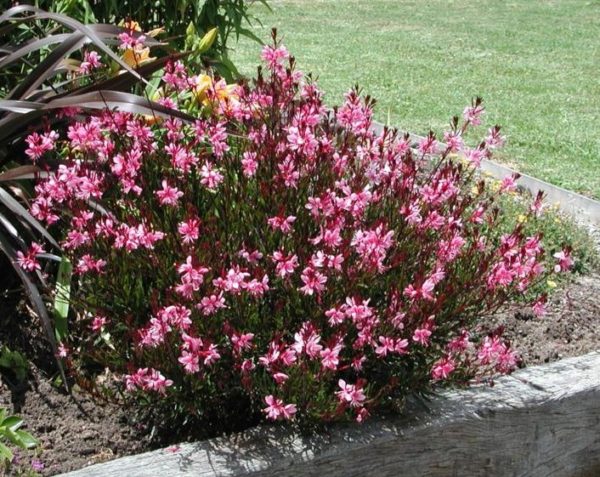 Pink Gaura Gaura lindheimeri ‘Siskyou Pink’
Pink Gaura Gaura lindheimeri ‘Siskyou Pink’
Adventurous gardeners will have discovered that a surprising number of drought tolerant plants that we might only expect to see in the full sun can tolerate and even welcome a good amount of shade, adapting to the lower light, (although they might respond with reduced flowering and sparser growth), but who can do all that experimenting to find out which ones work and which ones just won’t? It’s therefore great to know that a few growers of tough and beautiful plants for our climate, soils, and limited water supply have done this work for us and that they make their findings freely available. Here are the ones whose plants I use most often in my designs, and whose search tools make the selection of shade-tolerant plants easier!
One of the first to come to mind is San Marcos Growers in Carpenteria, CA. Since 1979 they have been growing “plants appropriate to California’s Mediterranean climate, including many California native plants, as well as vines, trees, shrubs, ferns, perennials, succulents, ornamental grasses and grass-like plants from other areas around the world.”
Their website offers a full plant inventory with photos and descriptions; it includes an “Advanced Search” tool that helps you zero in on their plants that tolerate shade: Check, say, ‘shrub’, and ‘tolerates drought’, and ‘shade’, then click on ‘submit’, et voilà! You’ll get a list of 348 shrubs tolerant of various degrees of shade, with their full descriptions.
This is an impressive number of dry shade tolerant shrubs! Here are a few that I found exciting because of their either unusual foliage or appealing form:
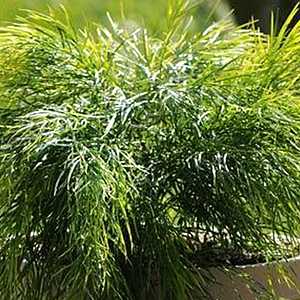 Little River Wattle Acacia cognate ‘Cousin Itt’
Little River Wattle Acacia cognate ‘Cousin Itt’
2-3 ft tall and 4-6 ft wide, its amazing foliage in low undulating mounds has an unusual, grass-like appearance, and I appreciate its appealing texture contrast to plants with fleshier foliage such as Honeybush, Aloes or large-leafed Bromeliads, or the rounder, hardy foliage of Coffeeberry or Creeping Barberry. As the grower says, it’s a “great plant for informal mounding along a dry stream bed, rock garden, tumbling down a slope or as a large potted specimen.”
Here are a few more shade-tolerant, water-wise shrubs and perennials:
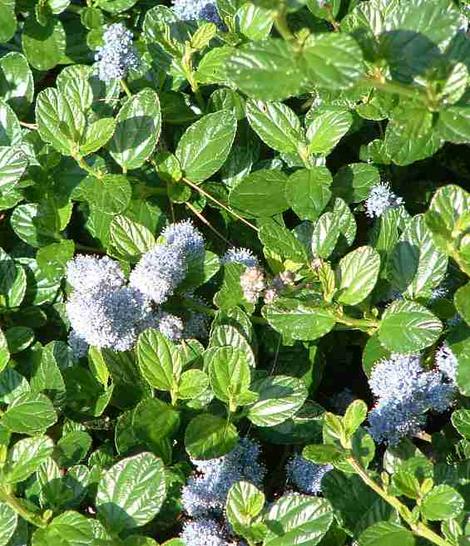
Yankee Point Ceanothus Ceanothus griseus horizontalis ‘Yankee Point’
A “fast-growing, durable groundcover.. 2 to 3 feet tall and spreads 8 to 12 or more feet … glossy, dark green leaves and bright blue flower clusters in winter through early spring. .. will grow inland with no watering once established when sited in partial shade. Especially effective as a large-scale groundcover where salt-laden ocean spray is a factor. Hardy to about 15° F… Judicious pruning is recommended to maintain a dense form and promote vigor. “
Yankee Point can also be used as a formal hedge and tolerates shearing with a hedge trimmer well. (It doesn’t like hacking though, a couple of hard prunings can kill it. Keep the garden hacks away from it.)
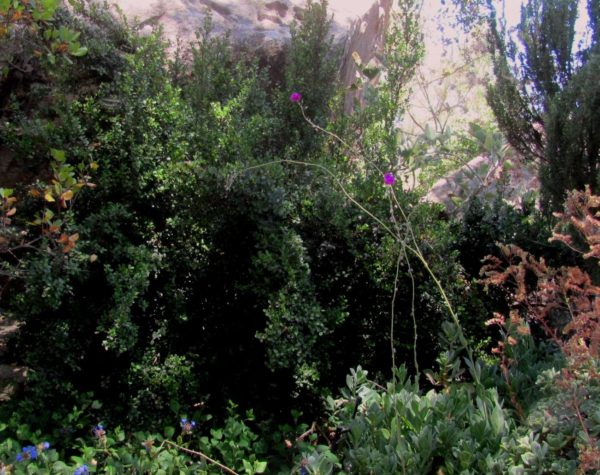 African Boxwood Myrsine africana
African Boxwood Myrsine africana
Here’s the “backbone” shrub that I described above, and what a versatile shrub it is! Evergreen, adapted to sun and shade, with an upright, slightly arching form, not too tall (5-7 ft), dense small-leaved foliage. It is a welcome backdrop to colorful and more ephemeral perennials planted in the foreground. It could be hedged if that fits your design.
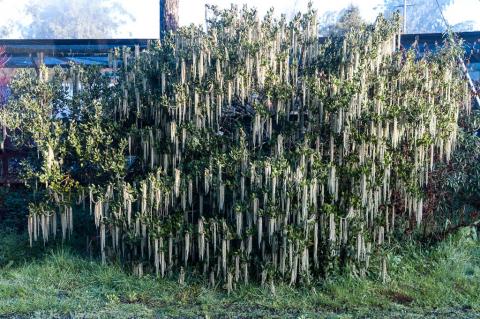
Evie’s Silk Tassel Garrya elliptica ‘Evie’s’
Here’s a large evergreen shrub or small tree, 8 to 10 feet round (could get larger in perfect conditions.) It is useful as background or specimen drawing the eye. Catkins of creamy white flowers with a maroon tinge appear each winter. Full sun or part shade, quite drought tolerant although it can handle summer water. Salt and wind tolerant. Use it as an excellent screen, informal hedge, or espaliered. It’s a Bay Area native.
 Carpet Geranium Geranium incanum
Carpet Geranium Geranium incanum
This is a tender South African perennial that forms bushy 10-inch tall mats of delicate wiry leaves and pale mauve flowers that appear from spring to fall. Trim plants after bloom flush to prevent seeding. Cut to the ground every other year to tidy up the clumps. A very tough plant in the coastal garden, tolerating drought and neglect. It makes a good groundcover in full sun. It is hardy to about 20 degrees F. A most beautiful weed!
Although only a wholesale nursery, San Marcos Growers deliver to many local nurseries, and you can order here your favorites. (See their Retail Nursery Locator as well as their Online Nursery Page)

Pink Gaura Gaura lindheimeri ‘Siskyou Pink’
What’s not to like about this airy and delicate native from Mexico/Texas? In the spring it sends up arching sprays of small orchid-like blooms and continues to flower throughout the summer. It loves the sun but is also ideal for planting beneath desert trees. Just remember to give it enough room so you can enjoy it fully (3-4 ft spread).
Mountain States Wholesale Nursery, in their work of over 43 years, they have grown desert-adapted plants that “include hues and forms which far surpass our earlier hopes of adding texture, refinement, brilliance – pizzazz, if you will – to already proven durability…. To assist you in your selection process, Mountain States Wholesale Nursery offers over 450 taxa of desert-adapted trees, shrubs, ornamental grasses, accents, flowering perennials, groundcovers, and vines. We specialize in providing landscape plants that combine beauty and water economy.”
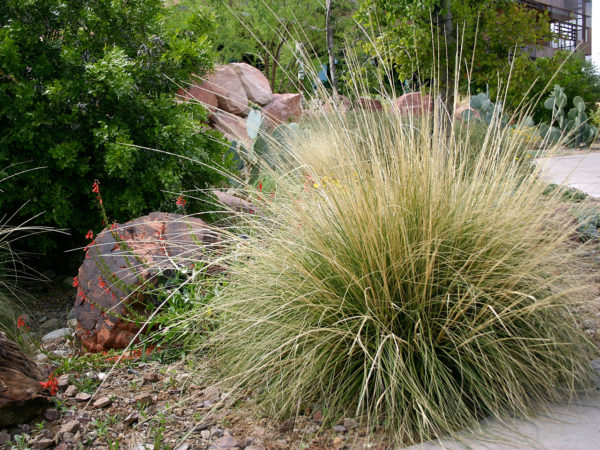
Deer Grass Muhlenbergia rigens
I love ornamental grasses. Nothing else softens boulders, sturdy cacti, and fleshy succulents more naturally and evokes water having just vanished in a seasonal creek… As MSWN describe it at their website: “ Dependable and adaptable, Deer Grass is the backbone of many desert gardens… Native to the Southwest at elevations up to 7000 feet, Deer Grass thrives in varied conditions. It flourishes in full sun, difficult reflected heat exposures and tolerates quite a bit of shade. Deer Grass is extremely drought tolerant, although the foliage browns out if adequate water is not available in the summer. It also handles high rainfall, virtually any soils, and is hardy to -10ºF, USDA Zone 6.
Here’s what Wendy Proud, MSWN’s California Sales Representative wrote in her recent newsletter:
“Changing over from a water loving landscape to one which is less thirsty can be tricky in the shade. Dry shade probably has the least amount of plants available compared to other possible zones in the landscape. Specific irrigation needs are key along with reasonable expectations about the speed of growth, blooming and eventual size of the plants being chosen. Mountain States certainly offers plants that can handle some shade and actually many would say they like it…. if they could speak. 🙂 Attached is a list of those plants who like shade, which can also be found on our website.
There’s a tab labeled “Information Sheets” on the left side of our homepage that will direct you to more groupings of plants for specific issues or areas of interest such as, Salt Tolerant, Rabbit Resistant or Hummingbird Paradise. Really helpful lists when you’re needing suggestions. “
And here the entire MSWN plant list for dry shade.
Although MSWN is a wholesale grower, their plants are either available through local retail nurseries or can be ordered here. And here’s the list of retail nurseries that MSWN delivers to: http://www.mswn.com/links/more
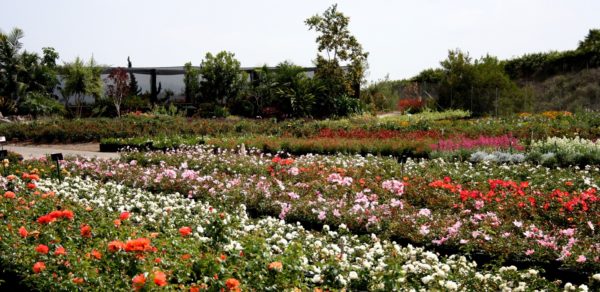
A retail & wholesale nursery that is a delight to visit (with a much shorter drive) is Waterwise Botanicals in Bonsall (WWB). The “acres of beautiful nursery and growing grounds, including demonstration gardens, ponds, and a shade house full of creative treasures to inspire you“ will put any plant lover to the resistance test; the signage on their plants is excellent, as is their online plant catalog with photos and descriptions.
Here I found lots of dry shade tolerant plants, and I was especially surprised to find a shrub here that’s a smaller version of the very popular Tea Tree, growing in the shade!
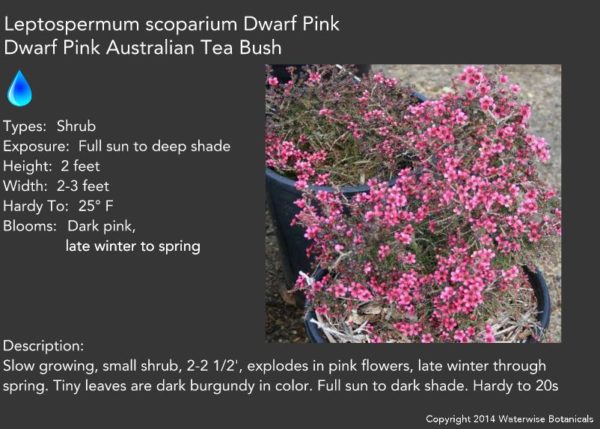
‘Dwarf Pink’ Tea Tree Leptospermum scoparium ‘Dwarf Pink’
I like its dainty appearance, its convenient size (only 2 ft tall by 2-3 ft wide) and delicate foliage of tiny burgundy leaves, all attributes that invite to combine it many other colors. Imagine how appealing it would look placed next to a fleshy purple/burgundy succulent such as Aeonium ‘Silk’.
Don’t wait to visit this nursery! Regular events for the garden enthusiast also make this a great place to visit. Most entertaining are their ponds that the manager Tom Jesch built himself without filters, without pumps, beautifully balanced with aquatic plants, fish, and turtles. These ponds draw lots of wildlife and invite to take a seat alongside and observe the goings on.
The WWB blog contains entertaining and useful information. Here’s one that I especially appreciated: Summer maintenance of ornamental grasses!
I hope that putting a satisfying low-water-use plant composition together for the shady parts of your garden is a bit easier for you with the above-listed websites and tools. Even here, I’d suggest to strive for balance of size, texture, form and color. I myself start “from the top”: After making sure that there is an overhead shelter or roof of sorts (the eaves of a house, or the canopy of a tree or large shrub), I start with one or more woody shrubs as background structure (Myrsine f.e. – see above) that sort of glue and hold all together. To me, woody plants also add the sense of longevity and permanence. Then I consider the midground, if there is room, such as a mid-size shrub. Finally, I work on the foreground where I place a shorter perennial or succulent (by nature the more short-lived plant – for ex. Gaura – see above). Lastly, color is often something I find least important in these compositions, as it always seems to fall into place, and insisting on the perfect color simply reduces the number of available plants to nothing.
It feels good to recommend these growers; their dedication to offering a wide range of water-wise plants that are well suited to our soils and environment, be they in the sun or the shade, on the coast or in the desert, helps me contribute a small part to the preservation of our natural resources, without sacrificing the delight in our gardens.
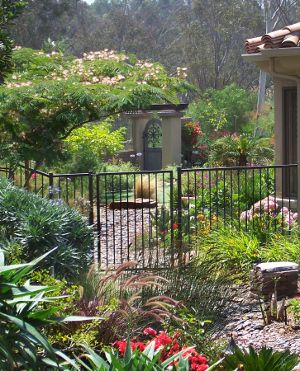
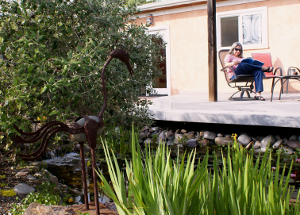
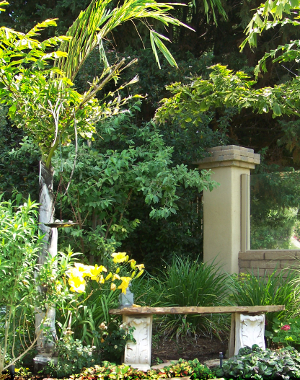
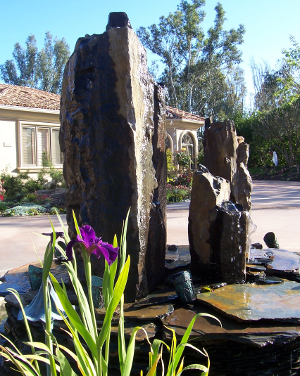
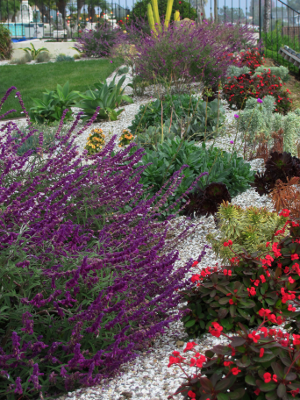
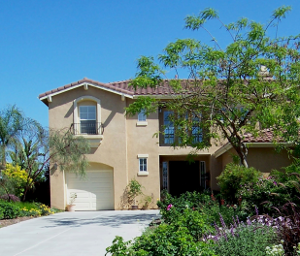
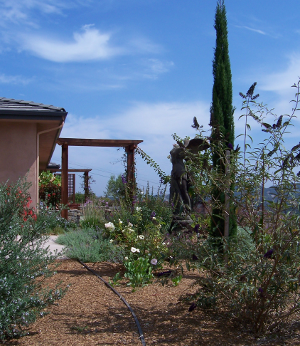
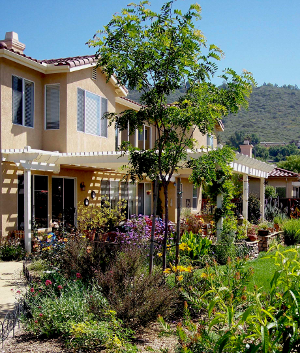 structure (foundation walls, patios, walkways, driveways) that could restrict its growth, or where the roots could do damage later down the road.
structure (foundation walls, patios, walkways, driveways) that could restrict its growth, or where the roots could do damage later down the road.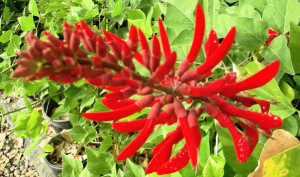 Coral Tree (Erythrina bidwillii)
Coral Tree (Erythrina bidwillii) 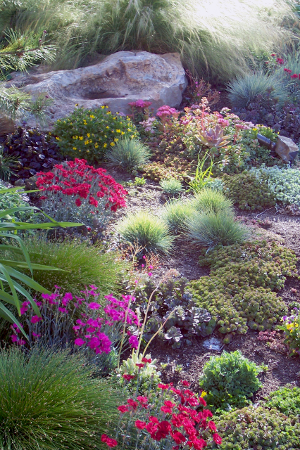
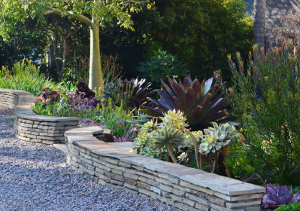 Thus, starting with the structure(s) can remedy the underlying defects or shortcomings of any landscape. But should you begin in the front yard, or rather the backyard?
Thus, starting with the structure(s) can remedy the underlying defects or shortcomings of any landscape. But should you begin in the front yard, or rather the backyard?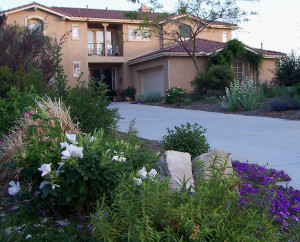 If it’s the front yard that needs refreshing, ask yourself: What’s there to invite a visitor to walk up to my front door? Could the trash cans be hidden behind their own enclosure? Are the irrigation valves out of sight? Is it safe for walking; are the steps even, the lighting sufficient, the path wide enough?
If it’s the front yard that needs refreshing, ask yourself: What’s there to invite a visitor to walk up to my front door? Could the trash cans be hidden behind their own enclosure? Are the irrigation valves out of sight? Is it safe for walking; are the steps even, the lighting sufficient, the path wide enough?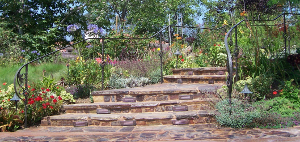
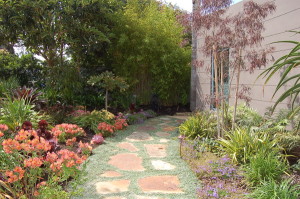 As a response perhaps to the stress of urban life and our isolation from nature, I get a lot of requests for flagstone and DG as pavement material because they are perceived as more naturalistic, and flagstone is very “in” these days. A flagstone path with green plants between the flat stones can look very attractive. The reality, unfortunately, is that these “inter-plantings” are rarely successful: As these plants need to be watered, this kind of pavement doesn’t contribute exactly to water savings, and it’s advisable to apply the irrigation at times when any puddles on the irregular surfaces of the stones can evaporate before the morning use.
As a response perhaps to the stress of urban life and our isolation from nature, I get a lot of requests for flagstone and DG as pavement material because they are perceived as more naturalistic, and flagstone is very “in” these days. A flagstone path with green plants between the flat stones can look very attractive. The reality, unfortunately, is that these “inter-plantings” are rarely successful: As these plants need to be watered, this kind of pavement doesn’t contribute exactly to water savings, and it’s advisable to apply the irrigation at times when any puddles on the irregular surfaces of the stones can evaporate before the morning use.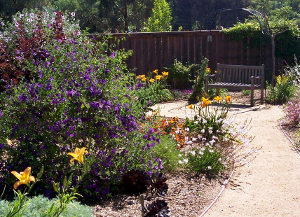
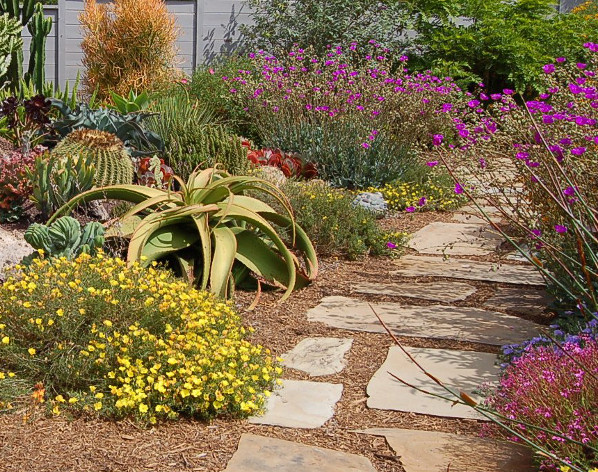
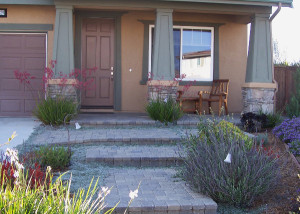 Interlocking (or segmental) pavers
Interlocking (or segmental) pavers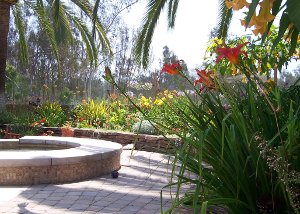 The pavers are easy to remove if necessary (for instance when you want to add a footing for a shade structure or other features later); cracking can never occur (as would be possible with concrete pavement).
The pavers are easy to remove if necessary (for instance when you want to add a footing for a shade structure or other features later); cracking can never occur (as would be possible with concrete pavement).